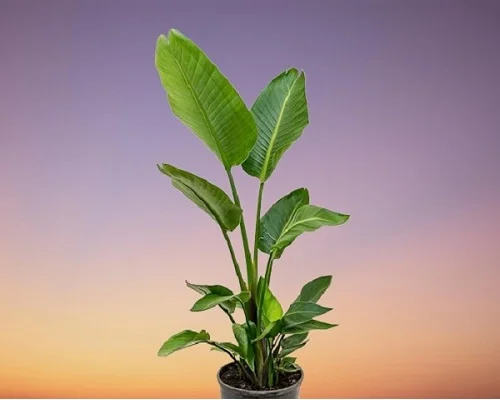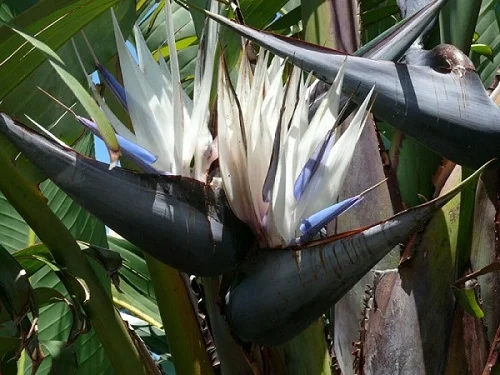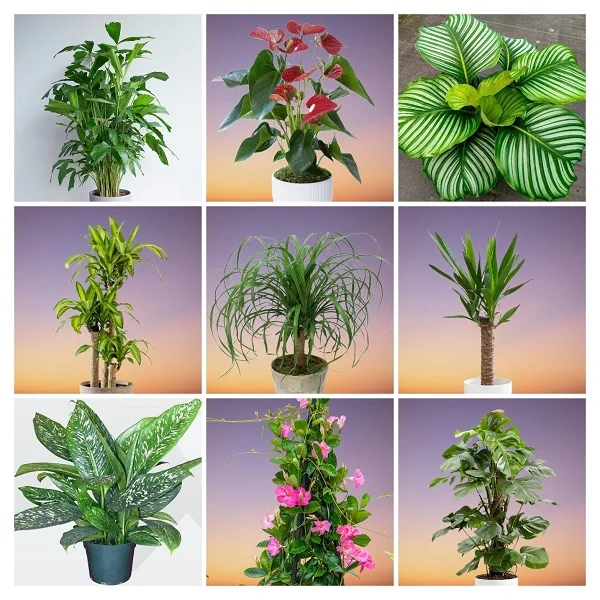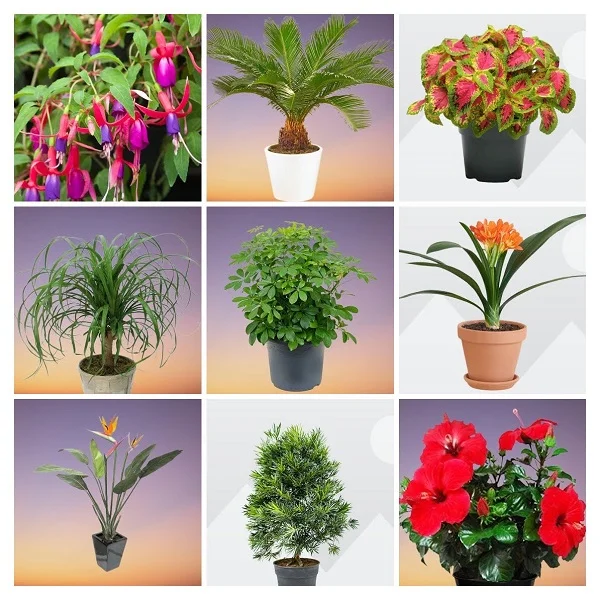White Bird of Paradise Plant (Strelitzia nicolai) Care, Propagation, Problems and Remedies
Some links in this post may be affiliate links
White Bird of Paradise Plant (Strelitzia nicolai) flourishes in bright light with 6-8 hours of direct sunshine, average warmth, humid conditions and consistently moist, rich, well-drained soil coupled with monthly feeding in the growing season.
Strelitzia nicolai also called Giant Bird of Paradise Plant is among the popular flowering plants and bears large, paddle-shaped, grey-green leaves, arranged like a fan at the top of the stems.
Giant Bird of Paradise is frost-tender below 00C and is suited for the warmer climates. In the US, the plant is a common landscape plant in California and Florida where there is no threat of frost. It is ideal for USDA zones 10-11.
In colder climates, White Bird of Paradise is grown as an indoor plant or in containers which can be taken inside during the harsh winter weather where they can be sheltered from frost.
White Bird of Paradise Plant is a clumping plant which requires a large space to grow away from buildings as the roots are invasive.

Botanical name: Strelitzia nicolai
Family: Streltiziaceae
Common names: White Bird of Paradise Plant, Giant Bird of Paradise Plant, Wild Banana
Origin
Strelitzia nicolai (White Bird of Paradise Plant) is native to the evergreen coastal forest and thickets of eastern South Africa, Mozambique, Botswana and Zimbabwe. It has been naturalized in eastern Mexico.
Size
Giant Bird of Paradise Plant can grow to a height of about 20-30 feet and 6-10 feet wide outdoors and in its natural habitat. Indoors, it grows to about 6-7 feet high and 3-5 feet wide making it one of the best tree-like plants perfect for the large spaces.
The evergreen, large leaves in White Bird of Paradise Plant are about 3.5 feet wide placing it among the large-leafed plants for a bold statement in any space in the home, office and other suitable places.
Flower
Giant Bird of Paradise Plant inflorescence comprises of dark-blue bract, white sepals and a bluish-purple 'tongue'. The plant may take up to 4-5 years to mature and begin blooming. The flowers develop into triangular seed capsules.
The inflorescence is about 7 inches high by 18 inches long and is held at a point above where the leaf fan emerges from the stem. On account of its spectacular blooms, Strelitzia nicolai is a popular flowering plant for the indoors.
Symbolism
White Bird of Paradise flower symbolizes joy, freedom, excitement, anticipation and paradise. The flower also represents love, faithfulness and thoughtfulness. It is the official flower of the 9th wedding anniversary in Hawaiian culture.
Toxicity
Giant Bird of Paradise Plant is mildly toxic to humans and pets. If ingested, it can cause mouth and stomach irritation. Keep the plant away from children and pets.
Related Plants
Popular plants that are related to Strelitzia nicolai include Strelitzia reginae (Bird of Paradise Plant) with vivid bright orange and blue flowers, and Traveller's Palm (Ravenala madagascariensis) which is one of the most spectacular plants for home growing.
Where to Buy
White Bird of Paradise Plants are a great addition to any plant collection. The Plants are available online on Amazon (Link to Amazon) or on Etsy (Link to Etsy).
Strelitzia nicolai Care Indoors
White Bird of Paradise Plant (Strelitzia nicolai) performs best in bright light with 6-8 hours of direct sunshine, average warmth of 18-270C, humidity of 60-70% and consistently moist, fertile, well-drained, all purpose potting mix coupled with monthly feeding in the growing season.
Giant Bird of Paradise Plant requires repotting every 3 years when pot-bound as they bloom best when the roots are confined. Pruning is needed to keep the plant neat and also discourage pest and disease infestations. Keep on reading for more on these growing conditions and how to achieve them.

Light Requirements
White Bird of Paradise Plant grows best under bright light with at least 6-8 hours of direct sunshine. If the plant does not get adequate light, it will grow slowly and will not bloom. Therefore, place the plant next to a very bright window or a brightly lit place.
Where the natural light is too little, consider investing in grow lights. Check out these full spectrum grow lights on Amazon.
Rotate the pot regularly to ensure that the plant receives light on all sides for uniform growth and prevent lopsided growth.
Outdoors Giant Bird of Paradise can be grown under direct sunlight but it needs to be protected from too hot sunshine. Do not expose the plant to direct sunlight before acclimating it as it can lead to sunburn marks (brown leaf spots). It is one of the sun-loving plants for the sunny locations.
Water Requirements
Water White Bird of Paradise Plant deeply during the growing season and keep the soil moist while allowing the top 1-2 inches of soil to dry out between waterings.
Decrease watering during the cold season to maintain the soil slightly moist as growth is minimal at this time but do not allow the soil to dry out completely.
Use water that is at room temperature to water to avoid shocking this tropical plant. The water should also be chlorine-free as the plant is sensitive to chlorine and other chemicals dissolved in water and it responds with brown speckled leaf marks.
Make sure that the pot has a drainage hole to prevent the soil from getting soggy as it can lead to root-rot which is indicated by yellowing and droopy leaves.
Temperature and Humidity
White Bird of Paradise Plant thrives in average warmth of 18-270C with a minimum of 130C. Keep it away from both drafts from air vents, radiators, heaters, windy doors and windows among others.
White Bird of Paradise Plant requires a humidity of 60-70% to thrive as low humidity will result in brown, crispy leaf tips and edges. Set the pot on a wet pebble tray or use a cool mist humidifier to elevate humidity.
Once in a while, clean the leaves by damp-wiping with a soft cloth to get rid of dust to ensure adequate surface area for light absorption and also minimize pests infestation. Ascertain that there is proper ventilation to discourage fungal diseases.
Potting Mix
The best potting medium for White Bird of Paradise Plant should be acidic, rich in organic matter and free-draining to prevent it from getting soggy while providing the required nutrients. Most all purpose potting mixes are ideal for this plant.
Fertilizer
Feed Strelitzia nicolai with a phosphorous-rich, water-soluble fertilizer monthly during the growing season to promote flowering. Do not feed in the cold season as growth is minimal at this time therefore the plant does not need it. Excess feeding can result in brown speckled leaf markings.
Regularly, flush out accumulated salts (which may have arisen from the water or fertilizers) from the soil by running for a few minutes a steady stream of water through the soil until it comes out through the drainage holes. Repeat the process several times.
Repotting
Repot the young White Bird of Paradise Plants at the beginning of the growing season in a pot one size larger than the current one to provide adequate space for growth. The mature plants require repotting every 3 years as the plant prefers to be root-bound to enhance flowering.
Ensure that the pot has a drainage hole and that the soil is free-draining soil to prevent it from getting soggy as it can lead to root-rot. Take a look at these pots with multi mesh drainage holes on Amazon.
White Bird of Paradise Plant Outdoor Care
White Bird of Paradise can be grown outdoors in the warm climates (USDA Zones 10-11) where there is no threat of frost, though it can tolerate upto -20C for a short period without much damage.
Grow White Bird of Paradise Plant in full sun to light shade. However, protect the plant from harsh hot sunshine to prevent scorching (brown leaf spots).
Where the summers are very hot, grow Giant Bird of Paradise Plant in a shaded spot or in containers which can be easily moved to a shaded area when the sun is too hot.
Plant the White Bird of Paradise Plant in a sheltered place away from strong winds as they cause the leaves to be torn and ragged.
Ensure that the soil is well-drained and rich in organic matter. Avoid heavy clay soils as they retain too much water which can lead to root-rot and death of the plant.
Keep the soil moist through out the growing season while allowing the top 1-2 inches of soil to dry out between waterings for optimum growth but avoid soggy soil. Cut down on watering during the cold season as growth is reduced at this time.
Fertilize White Bird of Paradise Plant with a phosphorous-rich, fertilizer monthly during the growing season to enhance flowering.
Withhold fertilizer during the cold season as growth is reduced at this time and excess fertilizer can lead to brown speckled leaf markings.
Provide adequate space for Giant Bird of Paradise Plant as it is a large clumping plant. Keep it away from buildings as the roots are invasive.
Pruning
Pruning White Bird of Paradise Plant involves removal of dead blooms and yellow leaves to maintain the plant neat as well as discourage pest and disease infestations. Cut the dead leaves at the base with sharp knife or a pair of scissors.
Always use sterilized tools to prune your plants to minimize cross-contamination. Ensure that the cutting tool is sharp enough inorder to make clean cuts to avoid unnecessary injuries which can lead to disease infestations.
Propagation
White Bird of Paradise Plant (Strelitzia nicolai) propagation can be done at the beginning of the growing season from seeds or by plant division at repotting time.
How to propagate White Bird of Paradise Plant from seeds
Sow the White Bird of Paradise Plant seeds about 0.5-1 inch deep in moist free-draining soil.
Cover the set up with clear polythene to create warm and humid conditions to hasten germination and establishment of the plants.
Place the set up in a warm, brightly-lit place and maintain the soil moist thorough out and avoid soggy soil as it can cause rotting.
Germination should occur in about 8 weeks. Allow the Strelitzia nicolai to be well established before transplanting after which you can begin routine care.
How to Propagate Plant White Bird of Paradise by plant division
During repotting, divide the mother White Bird of Paradise Plant into several sections while ensuring each divison has some roots to hasten establishment.
Pot the sections in moist, free-draining soil in individual pots.
Place the set up in a well-lit place and maintain the soil moist until new growth emerges on the sections.
Ensure that the crown of the sections is above the soil level to avoid rotting.
Allow the new Strelitzia nicolai to be well established before transplanting after which you can begin routine care.

Strelitzia nicolai Growing Problems and Solutions
White Bird of Paradise Plant (Strelitzia nicolai) problems include brown leaf tips and edges, yellow leaves, drooping, leaf spots and marks, lack of blooms, pests and diseases among others. Read on for more on these problems and how to fix them.
Diseases
White Bird of Paradise Plant is prone to root-rot which is promoted by soggy soil brought about by poor drainage of the soil. Ensure that the pot has a drainage hole and that the soil is free-draining to prevent it from getting soggy. Cut down on watering in the cold season to maintain the soil slightly moist as growth is minimal at this time. Learn more on how to treat root-rot in houseplants.
Pests
The common pests in White Bird of Paradise Plant are spider mites, aphids, whiteflies, mealybugs and scales. Isolate the affected plant to prevent spread to other plants and treat it for the pests. Learn how to identify and get rid of pests in houseplants.
Lack of blooms
There are two possible causes of lack of blooms in White Bird of Paradise Plant. One possible cause is too little light. Move the plant to a brighter spot where it will receive bright light with 6-8 hours of direct sunshine. If the natural lighting is not adequate, instal grow lights to supplement it. Check out this post on understanding light for houseplants.
The second possible cause of lack of blooms in White Bird of Paradise Plant is underfeeding. Feed the plant monthly with a phosphorous-rich, water-soluble fertilizer in the growing season to promote flowering. Learn how to feed houseplants.
Yellow leaves
There are two possible causes of yellow leaves in White Bird of Paradise Plant. One possible cause is soggy soil (too wet soil) due to poor drainage. Ensure that the pot has a drainage hole and the soil is free-draining soil to prevent the soil from getting soggy.
In addition, reduce watering during the cold season to maintain the soil slightly moist as growth is reduced at this time thus the plant does not require much water. However, do not allow the soil to dry out completely. Learn more on how to water houseplants the right way.
The second possible cause of yellow leaves in Giant Bird of Paradise Plant is cold drafts resulting in too cold temperatures. Keep the plant away from cold drafts from windy doors and windows, air conditioning units and others to avoid drops in temperature. Maintain an average warmth of 18-270C with a minimum of 130C. Check out this guide on understanding temperature for houseplants.
Brown and crispy leaf tips and edges
Brown and crispy leaf tips in White Bird of Paradise Plant are caused by too low humidity. To increase humdity, set the pot on a wet pebble tray or use a cool mist humidifier. Read more on how to raise humidity for houseplants.
Drooping leaves and stems
There are four possible causes of drooping leaves and stems in White Bird of Paradise Plant. One possible cause is too dry air (low humidity). Set the pot on a wet pebble tray or use a cool mist humidifier to raise humidity.
The second possible cause of drooping leaves and stems in Giant Bird of Paradise Plant is incorrect watering; either underwatering or overwatering. Maintain the soil moist during the growing season while allowing the top 1-2 inches of soil to dry out between waterings. Cut down on watering during the cold season to keep the soil slightly moist but do not allow the soil ball to dry out completely.
The third possible cause of drooping leaves and stems in Giant Bird of Paradise is too high temperature due to exposure to direct sunlight or hot air (hot drafts). Shield the plant from direct sunlight by use of a light curtain to filter the light and keep it away from hot air vents or any heat source.
The fourth possible cause of drooping leaves and stems in Giant Bird of Paradise Plant is pests and diseases infestation. Regularly inspect the plant for diseases and pests and take appropriate control measures for these pests and diseases.
Brown leaf tips and edges
Brown leaf tips in White Bird of Paradise Plant are due to soggy soil (too wet soil). Ascertain that the pot has a drainage hole and that the soil is well-drained soil to prevent it from getting soggy. Reduce watering in the cold season to maintain the soil slightly moist as growth is minimal at this time but do not allow the soil to dry out completely.
Brown leaf spots
Brown leaf spots in White Bird of Paradise Plant are sun scorch marks caused by exposure of the plant to direct hot sunlight before acclimating it. Gradually acclimate the plant before exposing it to the hot direct sunshine outside. Move it to a slightly brighter spot every so often until it can withstand direct sunlight.
Brown speckled leaf markings
Brown speckled leaf markings in White Bird of Paradise are caused by accumulation of salts in the soil from the water used or from overfertilizing. The plant is sensitive to excess salts in the soil.
To get rid of these accumulated salts, flush (leach) them out occasionally by running for a few minutes a steady stream of water through the soil until it comes out through the drainage holes. Repeat the process several times.
You liked it? Share on social media.
Related Content
Amazon Associates Disclosure
Homeplantsguide.com is a participant in the Amazon Services LLC Associates Program, an affiliate advertising program designed to provide a means for sites to earn advertising fees by advertising and linking to amazon.com.





